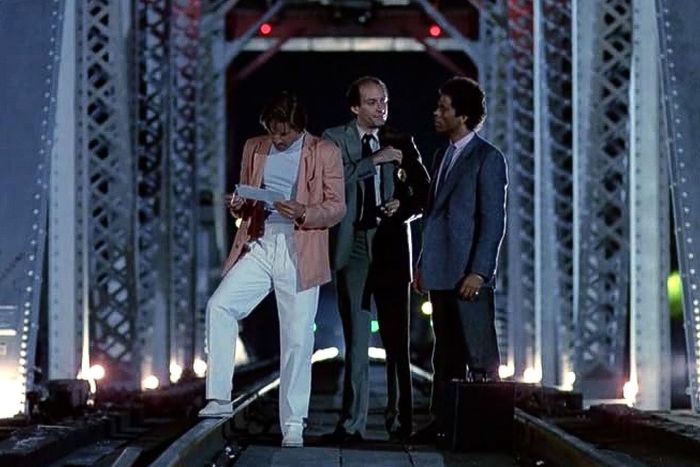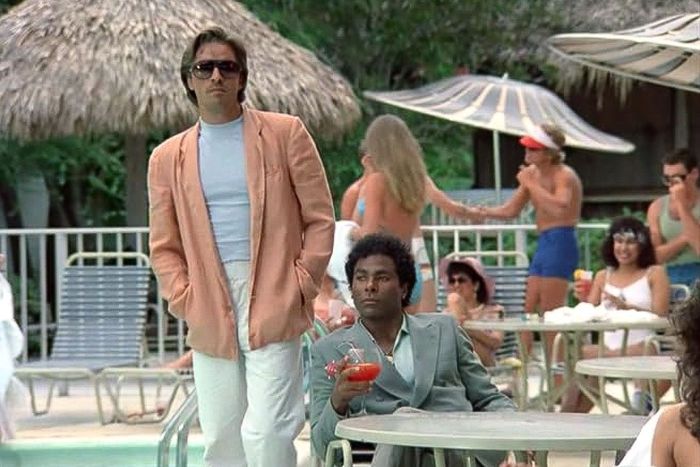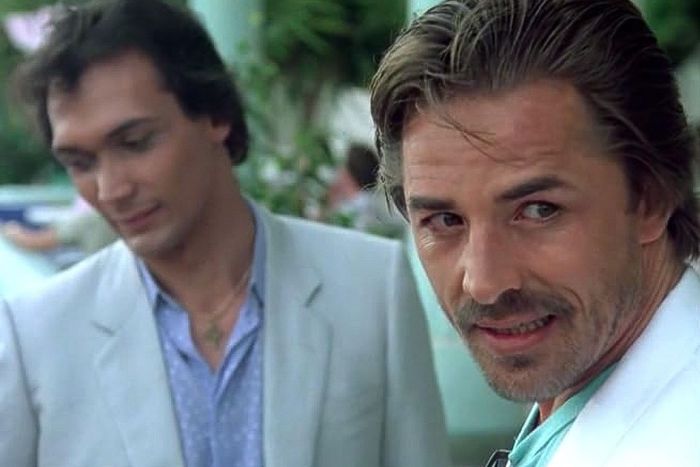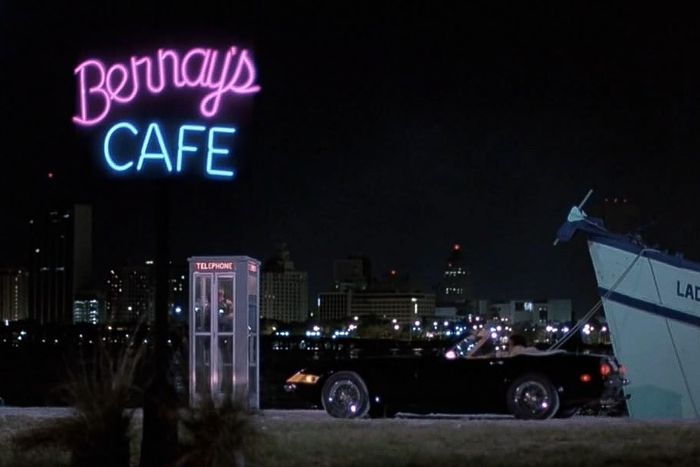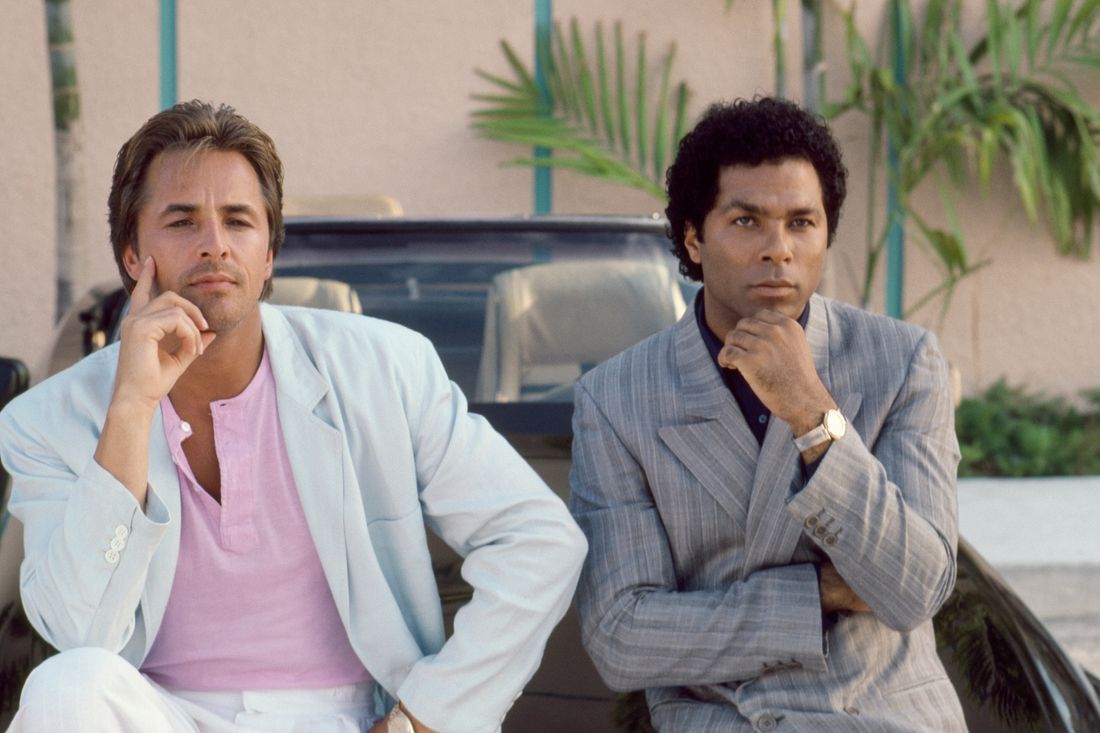
Cinematic television didn’t begin with Game of Thrones or True Detective or Mad Men or The Sopranos or even Twin Peaks. It began in September 1984 with the premiere of Miami Vice. The NBC show about a salt-and-pepper cop team was so immediately seductive and addictive that rival networks were burning money trying to develop Vice clones and keep up with the show’s awesome weekly displays of designer looks, hot cars, and hotter boats. Men around the world imitated Sonny Crockett’s (Don Johnson) go-to look: Ray-Ban Wayfarer sunglasses, a sports coat over a pastel T-shirt, slip-on shoes without socks, and stubble. The look became so popular that in 1986, the home-grooming manufacturer Wahl introduced the Stubble Device, an electric clipper that only shaved whiskers a little. Its original name, the Miami De-Vice, was changed to avoid a lawsuit.
Created by writer Anthony Yerkovich, helmed by filmmaker Thomas Carter, and guided by executive producer Michael Mann, Vice was ostensibly a police procedural: Crockett is a deep-cover operative based in Miami who partners with Ricardo Tubbs (Philip Michael Thomas), a New York detective who came to the Gold Coast to bust the Colombian drug lord who killed his brother. But it was more than the sum of its plot points. It was a Reagan-era update of hard-boiled crime fiction, about fallen characters who were cynical about life (Crockett smoked like a Bogart hero) but also looking for innocents to defend (and often watching in horror as they died anyway). It was a down-and-dirty portrait of the War on Drugs, and a critique of domestic and foreign policies that fed it, based on events that were really happening in the 1980s worlds of arms dealing and trafficking. Most of all, though, Vice was stylish.
The 97-minute Miami Vice pilot (two hours with ad breaks) aired on commercial TV but felt like it should’ve been in a theater. It was a shimmering postmodern neo-noir in the vein of movies like Paul Schrader’s American Gigolo, Mann’s Thief, and Brian DePalma’s Miami-based remake of Scarface (to which Vice would often be compared). It also owed a lot to the sexy-bloody-glossy Hollywood features directed by English TV-commercial wizards who had crossed the pond in the late 1970s and early ’80s, including Alan Parker (Midnight Express), Ridley Scott (Blade Runner), Tony Scott (The Hunger), and Adrian Lyne (Flashdance). Another element in the mix was MTV, which debuted in 1981 and normalized a music-video aesthetic that was more about highlights and moments than literary concepts of conventional storytelling.
These influences came together in an aesthetic that would later be called “cocaine chic” and in images that seemed to have been imagined not just as cinema frames but freestanding graphic photos that could hang alongside Patrick Nagel prints in a gallery. Each one provided a perverse kind of escapism: a dark fantasy depicting Miami as a dreamy, sensuous war zone dotted with glass skyscrapers, cobalt swimming pools, and pastels. Bad guys got away with murder sometimes. Innocent people were killed for no good reason. There seemed to be more ex-lovers than lovers. Vice’s Miami had torrential rain, deafening gunfire, languorous sex, and the most beautiful, broken people staring into space.
“But here’s a thing that’s hard for people who aren’t in this business to understand,” says Carter (another Hill Street Blues alumnus). ”Before a show is made, it doesn’t exist. It seems so obvious to us now that Don Johnson was the perfect guy to play Crockett and Philip Michael Thomas was the perfect guy to play Tubbs, just like it seems obvious that Miami Vice was this groundbreaking show that had all these great ideas. But the Miami Vice that we now know, with Don Johnson and Philip Michael Thomas in their cool suits and all the cars and the colors and the music, didn’t exist until it was created.”
If Vice felt cinematic, it’s because Tony Yerkovich, then 32, originally conceived the story as a theatrical feature (under working titles like Dade County and Gold Coast). It was one of the properties he was developing in 1983 as part of a deal he’d signed with MCA/Universal. His main creative partner there was Kerry McCluggage, senior vice-president of creative affairs for the company’s TV division, Universal Television. McCluggage, then 28, was a wunderkind who had overseen the development of Magnum, P.I., Murder, She Wrote, and The A-Team; he “recruited” Yerkovich based on his writing for Hill Street Blues. McCluggage says the Miami Vice script was discussed as a possible feature until the president of Universal’s film division, Frank Price, gave a green light to DePalma’s Scarface remake. This was deemed “a potential conflict” with Miami Vice because Scarface was also a Miami neo-noir crime drama with Latin characters at its center.
“We sent Tony to Miami to do some on-site research,” McCluggage says, “and he came back enthused about doing it as a series.” Yerkovich says the idea of Miami Vice as a TV show snapped into place when he was sailing into Miami on a boat owned by marijuana smugglers “possibly after ingesting hallucinogens. As we were coming into Miami, the city was vibrating, like on a molecular level. Like, where you can look at a leaf and sense the molecules vibrating with life in the leaf: I saw Miami like that. As vibrating pastels, right?” In July of ’83, with the backing of McCluggage and MCA/Universal president Robert Harris, Yerkovich sold the project as a weekly cop drama and was off writing a pilot script.
(Contrary to legend, NBC executive Brandon Tartikoff, who died in 1997, did not suggest Miami Vice to Yerkovich by writing “MTV cops” on a napkin, and Yerkovich, Mann, McCluggage, and Carter are all still irritated that he tried to claim credit. “Brandon didn’t start telling people that ridiculous story of writing ‘MTV cops’ on a napkin until at least 14 months after the pitch meeting,” Yerkovich says.)
Mann was focused on making theatrical films at the time (and would start drifting away in season two of Miami Vice to write, direct, and produce 1986’s Manhunter, a.k.a. Hannibal Lecktor’s screen debut), but Harris sent him the script anyway, and Mann agreed to sign on as producer because “the content was so good, it was so current.” He and Yerkovich shared an obsession with undercover officers devising “criminal” identities and using asset forfeiture to sell the lie by showing off seized cash, drugs, cars, boats, houses, and the like. Mann’s fixation stemmed from his muckraking journalist’s impulses; he’d traveled to research smugglers and dealers for unrealized projects that ended up being cannibalized for Vice plots.
“I was fascinated by undercover wealth, and I still am,” Mann says. “At the time, Miami was the northern banking capital for the money being made in the drug trade, and it was the kind of place I’m really attracted to, which is a twilight zone, be it Las Vegas or Miami, where life kind of exists in this liminal space between a very hard reality and a kind of momentary, transient experience. That’s Miami Vice, right? It’s the weather, it’s the sexuality, it’s the visuals, it’s the light, you know? All of it.”
Mann’s contribution to the aesthetic of the show was “huge,” Yerkovich says, from bringing in Mel Bourne — production designer of some of the most visually distinctive American films of the ’70s and ’80s, including Manhattan, Cocktail, Fatal Attraction, and Mann’s Thief and Manhunter — to consult on Vice’s look, to hiring Jan Hammer, a Czech fusion-jazz keyboardist, to compose all-new synth-driven instrumental music for each episode. “Michael was totally confident that the pilot would get picked up as a series,” says Hammer.
Philip Michael Thomas says that upon reading Yerkovich’s script, he knew he’d been cast in something groundbreaking (“The TV equivalent of the great pyramids of Egypt — a thing that will last forever”), and that the sensation only became more pronounced as the show began production in Miami in the spring of 1984. Nobody questioned the casting of Thomas; he was immediately accepted as the ideal Ricardo Tubbs. But the casting of Johnson as Crockett was a hard sell because he’d starred in multiple pilots that hadn’t gotten picked up. NBC worried he was a bad-luck charm. “There wasn’t a lot of enthusiasm from the network to hire him,” says Carter. “So we read other people. But we ended up casting Don.” (Johnson was the only major participant not interviewed for this piece; his publicist explained, “Don politely declines all these interviews as he just won’t go backward, only forward.”)
McCluggage says the only hiccup in Johnson’s performance came early in production of the pilot, when he and Yerkovich watched dailies and realized that during the first few days he was “kind of doing a bad Nick Nolte impression from 48 HRS.,” a buddy movie that had been a hit a few months earlier. The two flew to Miami to confer with Johnson and ask him to try a different approach. It was an awkward conversation, but “Don was grateful and really wanted this role to work. And he kind of acknowledged that he was channeling Nick Nolte in his performance and it just seemed a little forced for him, but he had the ability to just make a quick turn, and everybody was happy from there on out.”
After Carter set the cinematic style with the pilot, Mann and various cinematographers tried to keep Vice’s style as bold as possible, drastically varying the length of lenses; staging lengthy, complex crane shots in the manner of big Hollywood movies; and lighting night scenes with hard, bright lights that cast sharp shadows. “The rigor of doing 22 hours a season instead of six or eight or nine or ten was a challenge and a thrill,” Mann says. “I mean from the standpoint of both the writing of the episodes and the actual production: shooting each of the hours in seven days.” The key to staying on track, Mann says, was “inventing systems” that amounted to visually daring moments onscreen, but that were, at the same time, “very economical. We tended to, for example, light things with very large lamps that threw very dark shadows and not worry about the fill light. The effect was described as chiaroscuro. It also took 15 minutes to set up the light!”
Mann and his crew also committed to filling every frame with color. It wasn’t as easy as you might think. “When I first went to Miami, I took a close look at it, and it was almost as if there had been this massive mountain of tan paint left over from World War II and somebody had bought it all in surplus and sprayed the whole city with tan!” Mann says. “And then, when we did the research, it turned out that, no, those are not the colors that were used during the streamlined Art Deco period of Miami in the 1920s and 1930s that we were wanting to use; they were using pastels! Then I became interested in how you can combine different colors to generate a sense of heat. And that was when we started to have these subtle chromatic collisions, like having a very faint yellow against a pale blue, or turquoise against pink. What we basically did was return Miami to Miami.”
The result of all this imaginative labor was one of the most innovative pilots ever made for commercial TV. It created a stylebook that not only defined the rest of Vice (which aired 111 episodes) but drew praise as a beautiful object in itself. Hammer says that when he watched the first cut of the pilot, he was unprepared “for how beautiful it was. I thought, Wow — this is actually like something that I would watch.”
From the black-and-white expressionism of The Twilight Zone, to the Pop Art splendors of the original Batman and Star Trek, through the grubby naturalism approximated on MASH and Hill Street Blues, stylistically distinctive TV shows had existed prior to the 1980s. But Vice made them all seem like relics. It seized the prerogatives of formally adventurous international and art-house cinema from the 1960s through the mid-’80s and applied them to a TV show. It created not just a world but a mood — and sometimes let the mood be the world. The creative triumvirate of Yerkovich, Mann, and Carter and the rapport of Johnson, Thomas, and their co-stars — Saundra Santiago as Gina, Olivia Brown as Trudy, Michael Talbott as Switek, and John Diehl as Zito — proved alchemically perfect. The show had a pulse, a personality, a signature.
This all comes through in the extended (by network-TV standards) “cold open” of the pilot, which kicked off with Tubbs (not yet identified as a police officer) following Esteban Calderone around New York and failing to bust him at a nightclub. The sequence freeze-frames on the thwarted Tubbs standing alone in a dark alley, then hard-cuts to the credits, a feature-film-like opener that matches documentary-like footage of circa-1984 Miami to Hammer’s buzzy, pounding theme and lists Vice’s main actors without showing their faces (TV’s norm at the time). A graphic at the bottom of the screen boasted “In Stereo.”
Vice’s aesthetic comes through even more strongly in the climax of the pilot when Crockett and Tubbs drive to the docks to confront Calderone and his minions while Phil Collins’s “In the Air Tonight” blasts on the soundtrack at length. The sublimated sorrow of the brotherless Tubbs merges with the self-immolating despair of Crockett, who has just learned that a fellow cop who was like a brother to him is on Calderone’s payroll. Nobody had seen anything on network TV like this hypnotic, ominous sequence, which begins with the cops riding mostly in silence, save for a few terse lines and the sound of Tubbs loading his shotgun. It continues with Crockett’s convertible pulling up to what is apparently a French bistro at the edge of the harbor to walk to a glass phone booth and call his estranged wife, Caroline (Belinda Montgomery), and ask, “The way we used to be together … It was real … Wasn’t it?” Then Crockett gets back in the car and peels out, and the sequence returns to Crockett and Tubbs driving toward the docks. The cut from the phone-booth scene to the cops returning to the road falls precisely where the cosmos demands that it should: a split second after Collins’s timelessly badass drum fill.
“In the Air Tonight” had been a needle drop before (in 1983’s Risky Business during a sex scene). But it fit so well in the Miami Vice pilot — “It was a little bit recessed, those drums and those voices, and there was a little bit of echo, so that listening to it, you felt like they were in some hollow space,” Carter says — that some fans of the show wrongly assumed it had been written and recorded for use in that sequence. In future years, “In the Air Tonight” would become inextricably linked to Miami Vice, even though it had been released as a single in 1981 and was subsequently used in other movies and series (including the pilot of FX’s The Americans). “Two days after the pilot aired,” Carter says, “I’m listening to the radio, and the DJ says, ‘And now, from Miami Vice, here’s “In the Air Tonight,”’ and he plays the song. And I’m like, Whoa. Oh my God. The show had immediately taken ownership of the song.”
Mann describes the “In the Air Tonight” sequence as an experiment in form that aimed to pull viewers into a character’s subjective emotional state: “I wanted the show to drop you into … a crisis,” when “time slows and visuals ignite almost psychedelically.” Yerkovich describes the sequence as a tribute to Edward Hopper’s painting Nighthawks. Carter talks about creating a geographically nonexistent bistro in Bal Harbour by having a phone booth placed at the water’s edge, then instructing the art department to make a neon “Bernay’s Café” sign and hang it in the foreground. “You don’t see the café,” Carter says. “It’s almost like haiku or something, what we did there. It’s suggestions of what is. And as a viewer, you just go with it, right? You go, Yeah — they just pulled the car over at a bistro so this guy can call his wife.”
Carter also points out a detail that might not register on first viewing if viewers are immersed in the story: You don’t hear the sounds of revving engines or the whoosh of storefronts as Crockett and Tubbs ride through the city. Much of the sequence is unnervingly quiet, save for a few lines and specific sonic elements and, of course, Collins’s song. “There is power in taking things away,” Carter says. “It creates a mood. It focuses you. When you watch this sequence, you don’t go, Why am I not hearing the sound of the engines? You feel like you’re being pulled into something, even without knowing why. And at the end, you wake up and go, How much time just passed? Was it a minute? Was it 30 seconds? Was it two minutes?”
But it wasn’t just the pilot. Miami Vice season one was one of the best freshman seasons of that decade. It churned out one knockout hour after another (including the gemlike perfection of “Evan,” starring a then-baby-faced William Russ as a closeted gay cop). It sparked depiction-vs.-endorsement arguments about its presentation of sex, violence, and drug use. It soon became one of the hippest series in TV history to guest-star on, especially if you were a musician or a real-life political figure. Miles Davis, Frank Zappa, G. Gordon Liddy, Sheena Easton, Vanity, Captain Lou Albano, Chrysler boss Lee Iacocca, Leonard Cohen, and Thief co-star Willie Nelson all took turns charming, tormenting, or baffling Crockett and Tubbs. And it became a finishing school for future stars, including Liam Neeson (as an IRA terrorist) and Bruce Willis (as a wife-beating arms dealer). Luis Guzman was one of countless, now-ubiquitous character actors who got their big break on Vice. The show caught lightning in a turquoise bottle, electrifying every career it touched.
Miami Vice ended up receiving 15 Emmy nominations, more than Hill Street Blues. In a 1985 Time cover story titled “Cool Cops, Hot Show,” future Northern Exposure showrunner Joshua Brand, then a producer of Steven Spielberg’s anthology series Amazing Stories, said, “The success of Miami Vice shows that people do notice production values, lighting, and what comes out of those little television speakers.” But in a Rolling Stone interview from that same year, Mann pushed back against the praise heaped on the show: Vice seemed radical because TV had been so conservative for so long. “We haven’t invented the Hula-Hoop or anything,” he said. “We’re only contemporary. And if we’re different from the rest of TV, it’s because the rest of TV isn’t even contemporary.”
Mann, Carter, and Yerkovich are all generous in crediting colleagues with helping define the show’s overall artistic identity, which proved sturdy enough to remain consistent-ish over five seasons and several changes in management. (Yerkovich compares the core creative team to Aspen trees, which “seem like individual trees but are actually connected through a single root system, and can probably communicate.”) Toward the end of the show’s run, future Law & Order franchise mogul Dick Wolf took over producing, but Vice continued to look and sound amazing, even though Wolf has never, in 40-plus years of making television, been praised for his sense of style. Mann was careful to note in this interview that he only extrapolated what was suggested in Yerkovich’s script, amplified it, then took it over when Yerkovich left the show to create another NBC neo-noir, Private Eye (which co-starred Michael Woods and a young Josh Brolin). “Michael Mann did not create Miami Vice,” Mann says. “Tony did.” Carter is likewise effusive about the vision sketched in Yerkovich’s script, while Yerkovich reminds this reporter on four separate occasions that it was Carter who directed the “In the Air Tonight” sequence and chose the song. (“It’s true,” Carter says.)
In retrospect, the “In the Air Tonight” sequence is a before-and-after moment for TV, comparable in force to the effect on cinema of the Stargate sequence at the end of 2001: A Space Odyssey. I vividly recall reading a critic’s description of the phone-booth shot in his review of the pilot, back when TV critics rarely talked about how TV shows looked. This one described the composition of the phone-booth shot in detail and said it evoked Jean-Luc Godard’s Alphaville. At the time, I was a 15-year-old high-schooler in Dallas who had no idea who Godard was, much less what Alphaville was, and I’d bet Crockett’s black 1972 Ferrari Daytona Spyder that neither had ever been previously mentioned in relation to a cop show.
Vice inspired that kind of analysis because it was made by people who were legitimately, enthusiastically, publicly cinephiles. My first conversation with Mann, over 30 years ago, was about how the simple, repetitious music and oddly timed cuts in the final action sequence of The Last of the Mohicans were part of a conscious strategy to distort the audience’s perception of time and make five minutes of action feel like an endless nightmare — an effect that recurs throughout Vice’s run, no matter who an episode’s director happens to be. The mathematician-showman-philosopher aspect of Mann shapes even episodes of Vice that were made long after he’d left the series. Carter was a self-taught moviemaker whose film school was Los Angeles–area art-house theaters, where he sought out works by postwar European cinema legends, the American New Wave directors who worshiped them, and the aforementioned ad-trained Brits. Yerkovich says that although he considers the Godard-Alphaville comparison “flattering,” he was a bigger fan of two other French New Wave figureheads, Jean-Pierre Melville (Le Samourai, Le Cercle Rouge) and Claude Chabrol (Web of Passion, Les Boucher). As Yerkovich speaks of wanting “to place an existential hero in a city in which the American dream had been distilled into something perverse, a city whose moral base was as shifting and insubstantial as the sands on which it was built,” he cites William Butler Yeats, Raymond Chandler, and Dashiell Hammett.
But by the time the season-two premiere, “Prodigal Son,” aired in the fall of 1985 — another movie-length episode, this time sending Crockett and Tubbs to New York on assignment and having Tubbs reconnect with an ex-lover, played by none other than blaxploitation goddess Pam Grier — there were signs that Vice was leaning too hard into its Vice-ness, especially in its use of music to summon an epic feeling when the storytelling had gone slack. (The episode made a newly minted hit of Glenn Frey’s “You Belong to the City,” which played at length while Crockett strolled around Manhattan — far from the only time Vice padded its run time with a needle drop.) “You have to be careful to not allow the style of a thing to become the substance,” warns Carter. “That’s the thing, because style is not substance. Style is there to enhance the substance, to deepen it. If it’s there for its own sake, it quickly becomes hollow.”
Detours and misfires aside, Vice’s constellation of talent was such that the show continued to produce memorable episodes into its fourth and fifth seasons, when it became more slack and cartoonish and tried to jazz things up by giving Crockett amnesia that leads him to believe he’s his drug-dealing alter ego, Sonny Burnett. (My own Hall of Fame includes multiple episodes from seasons two through five, including “Out Where the Buses Don’t Run,” which has an all-timer sicko punch line; “Bushido,” which climaxes with Castillo using a samurai sword against gun-toting assassins; “Forgive Us Our Debts,” in which Crockett becomes convinced that a man he sent to prison for murder is innocent of the crime; and “Down for the Count,” in which Zito goes undercover as a boxing manager to bust a corrupt bookie.) “Tony left the show after 16 episodes, and I left the show to do Manhunter in ’86 and Crime Story after that,” Mann says. “But the established aesthetic and the writing of Tony’s pilot and the casting of Don Johnson and Philip Michael Thomas had so defined Crockett and Tubbs and that world that it made it very difficult to deform the show and get kind of average about it.”
“All the way through, there was always a lot to appreciate,” says Carter, who kept watching Miami Vice even though he never directed another episode after the pilot (by choice, he says; he’s more interested in the beginning, when he can have a hand in creating a style). “There were pros and cons, always. The pros: They brought in all these people, a lot of people, who you never saw on TV. So the show was really about opening a window to a lot of other faces and ideas. The cons: Sometimes, the faces and ideas worked, and sometimes they didn’t. But even so — even so! — there would be occasions where the story and the use of music and image on Miami Vice would marry in a way that would be really compelling. And when it did, it was unlike anything else on TV.”



